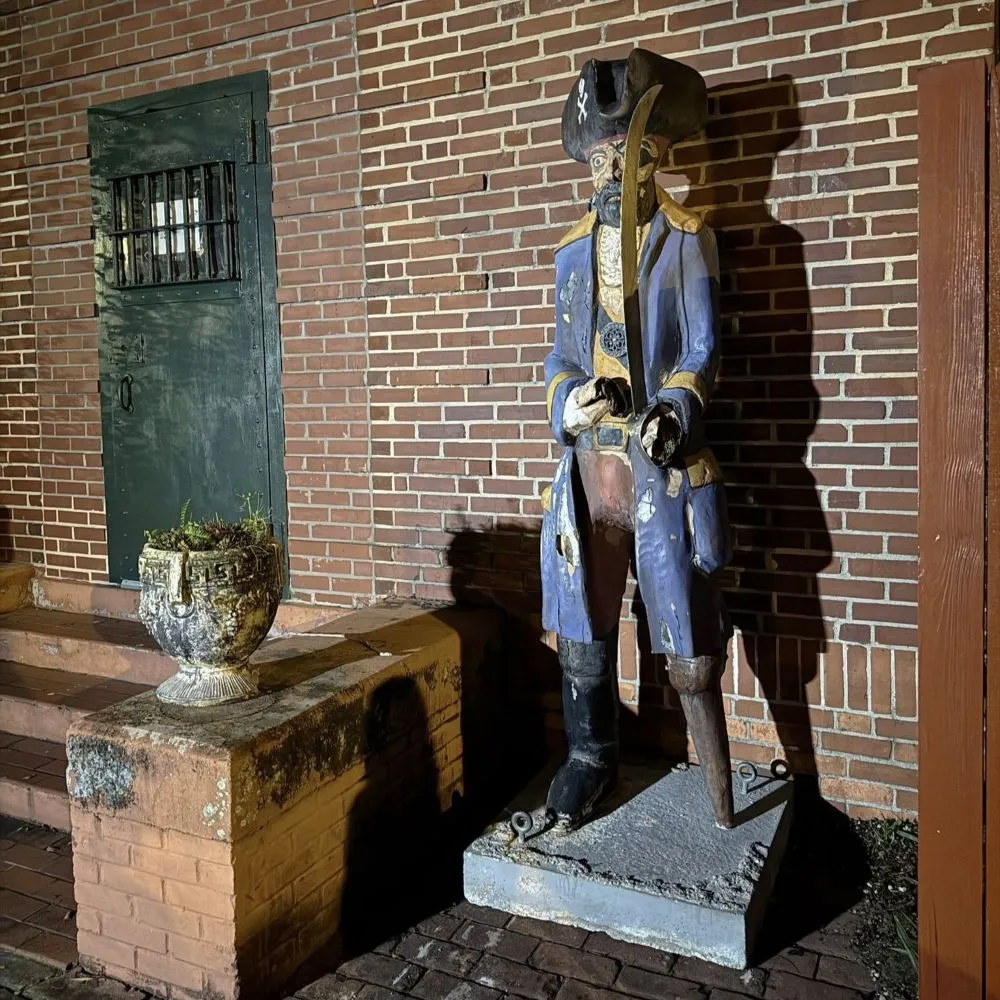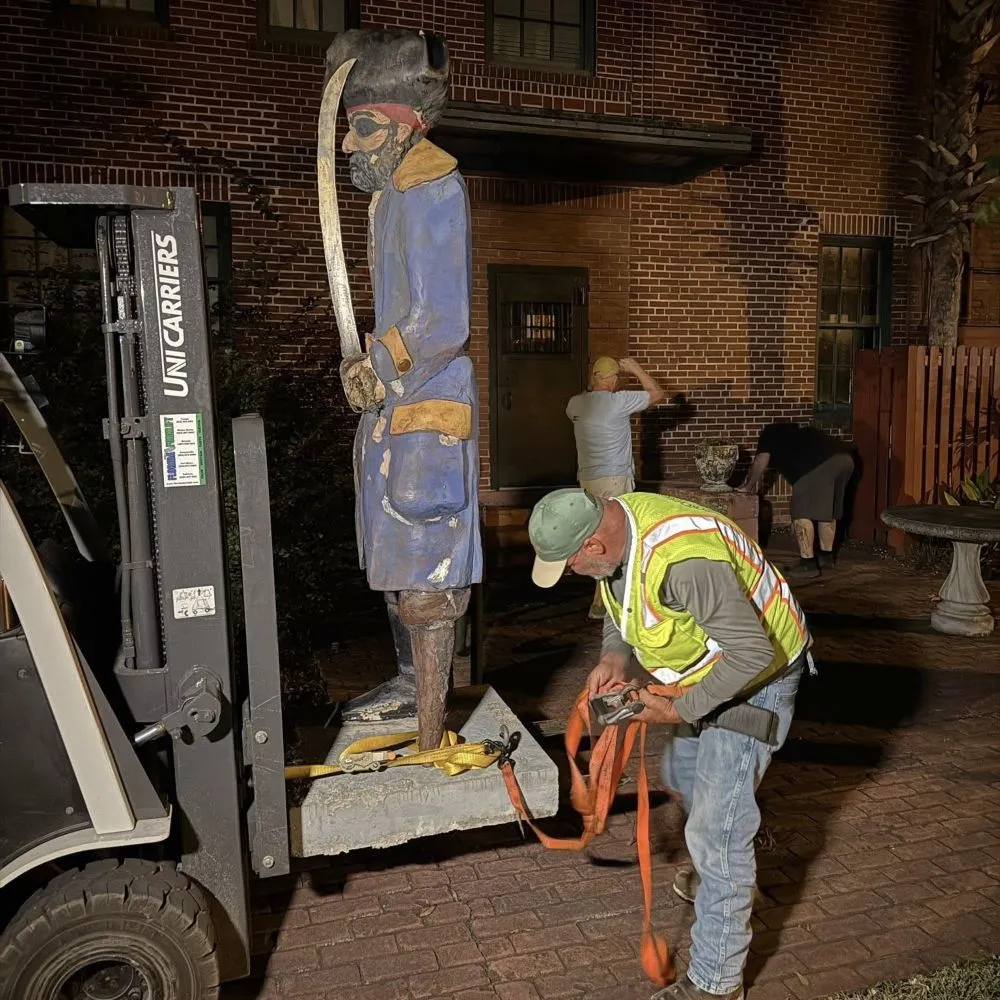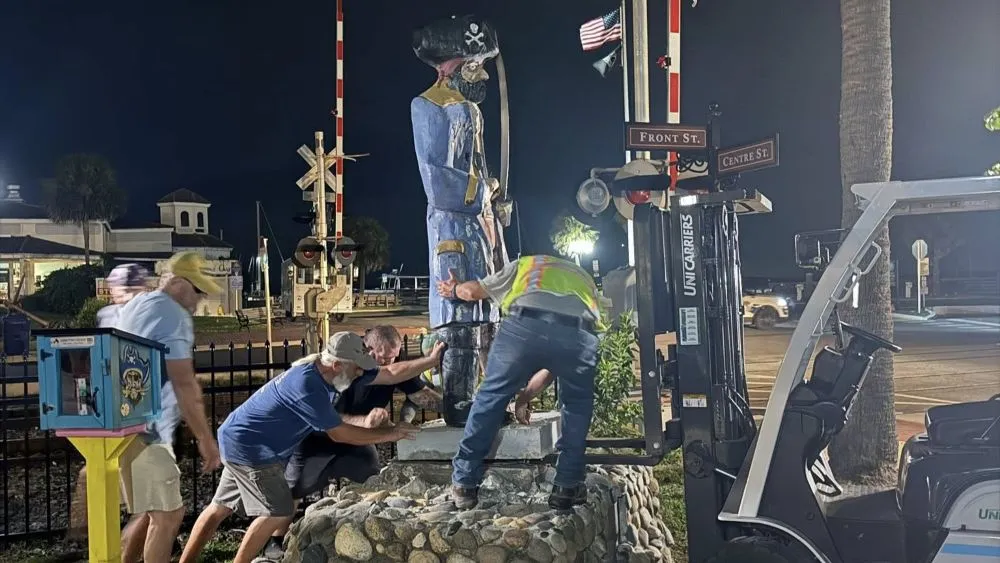Peg Leg Pete has a new home for now — in front of the Amelia Island Museum of History.
The popular wooden statue got a pre-dawn forklift ride to the museum from the front of the Amelia Island Welcome Center in Fernandina Beach.
The statue had been deemed unsafe for public display after 47 years on Centre Street’s historic waterfront. City crews and Fernandina Pirates Club volunteers removed the pirate early Thursday for the three-block ride to the museum on South 3rd Street.
Some of the cremated remains of a local pirate enthusiast still remain inside the wooden statue, apparently placed there in recent years.
An engineering company review requested by city officials last month said the oaken statue had deteriorated from age and weather and it was no longer safe for people to climb on it for photos.
In a Facebook post, city officials said preservation efforts are continuing and Pete is on public display at the museum, “ensuring that this familiar and iconic piece of Fernandina Beach’s maritime character remains accessible to the community.”

The Peg Leg Pete statue stands outside the Amelia Island Museum of History after it was moved early Thursday, Oct. 9, 2025. | City of Fernandina Beach
A photograph showed the statue standing outside the museum after the move, paint faded and cracked in some places. His left hand was deteriorated, and a hole was visible it his right leg.
Weighing in at 600 pounds, the statue is too big to fit inside the museum, which awaits further word from the city as to preservation efforts, executive director Phyllis Davis said.
“Unfortunately, he is also too large to fit in the covered cage area on the south side of our building where the old Palace Saloon Pirate is located,” Davis said in response to questions from Jacksonville Today. “Therefore, Pete will remain in his current spot on the east side of the museum, facing 3rd Street, for the foreseeable future. This will ensure access for everyone, day or night, as we await further information on his preservation.”
Peg Leg Pete’s origin
Artist Wayne Ervin used a single 10-foot piece of live oak to carve the pirate statue, which was placed on Fernandina Beach’s waterfront in 1978, then moved next to the visitor’s center.
City officials began seeing serious signs of weather damage on the 5-foot-tall statue in recent months as it stood atop a concrete base just off Centre Street.
In late August, a proposal for conservation was brought before the city’s Historic District Council, suggesting the statue’s move to the Amelia Island Museum of History for preservation. Another proposal was made to replace it with a new statue, commissioned a few years ago by the Fernandina Beach Pirates Club and carved by Jett Paxton.
During a meeting in late August, City Attorney Teresa Prince reported that she had heard from “a reliable source” that the statue holds human ashes.
Pirate Club President Joe Brown confirmed that he has seen the cremains and that the club even tried to find relatives of the person whose ashes are there. But Bobby Brown Jr., whose father donated the wood for Peg Leg Pete, said he remembered his father putting a box of keepsakes in its base, but nothing containing cremains.
Peg Leg Pete’s options
Despite concerns about the statue’s condition, the council tabled the statue’s swap and requested the engineering assessment.
The assessment, sent to city officials Sept. 5, states that the statue had “visible decay and soft areas noticed in several places,” with more damage probable under the surface.
The assessment gave two options: fence Peg Leg Pete, with signs telling people to stay off it, or move it “to a place out of possible physical interaction.” The city took the latter option Thursday.

City officials said the City Commission is still considering its next steps, including preservation and restoration of the current statue.
As for the cremains, they are apparently those of Pirates Club Vice President Paul M. Mathews Jr., who died in 2007.
In a newspaper obituary provided by the museum, “Mad MAXX,” as he was known, was a “very active member” of the club who asked that his ashes be shot from a cannon after his death.
In fact, Davis said, some of the cremains were apparently shot out of a cannon over Centre Street at the time of his passing. The rest of his cremains are still inside the statue, Davis believes, mixed with what was used to repair one of the legs a few years ago.
All the city says is that the cremated remains “have not been touched.”







